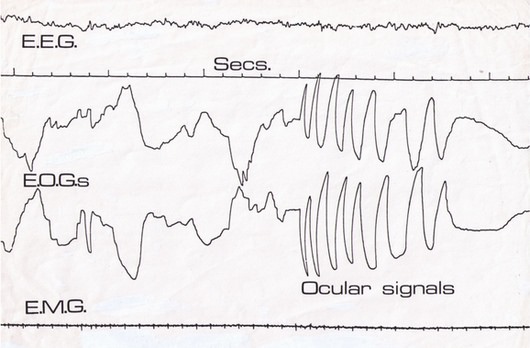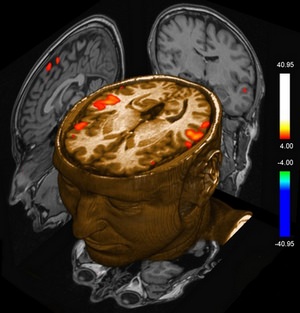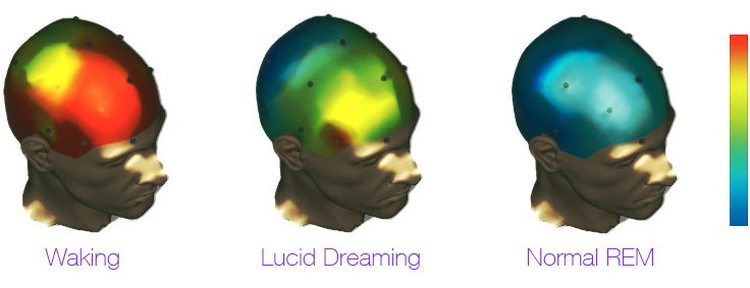Is Lucid Dreaming Real?
Is lucid dreaming real? Absolutely. It's as real as homeopathy, crystal power and tarot readings.
Just kidding. Unlike those things, lucid dreaming is scientifically verifiable in the lab and the effects can be replicated over and over. In fact, not only are there MRI brain scan studies from the last decade that prove the existence of consciousness in dreams, but as you'll see below, lucid dreamers actively participate in scientific experiments to further develop our understanding of consciousness.
The First Proof
The first scientific evidence of lucid dreaming came out of Hull University in the UK in 1975, when Dr Keith Hearne recorded the pre-determined eye movements of his lucid dreaming subject:
"[Through measuring Rapid Eye Movement] I had devised the signalling method in an attempt to circumvent the profound bodily paralysis of REM (dreaming) sleep - which inhibits any physical signalling.".
His subject, Alan Worsley, was wired to a sensitive multi-channel chart recorder and monitored through the night. Finally, at 8am, came a sequence of large zig-zag movements on the Electro-oculograph (EOG):

"On waking, the subject described how he suddenly realised he was dreaming, and consciously made the signals before continuing the lucid dream experience. They were the first ever signals communicated from within a lucid dream," explained Dr Hearne.
"It was an amazing, mind-boggling, situation. I was looking at a communication from a person in another room who was asleep, 'unconscious', dreaming, yet in his own vivid world in which he was perfectly conscious and interacting with others. It was his reality - I was in my reality. A channel of communication had been established between those two realities."
This remarkable proof of lucid dreaming is now on permanent display in the London Science Museum.
Your Brain When Lucid
In more recent years, scientists have made use of functional Magnetic Resonance Imaging (fMRI) techniques to study the brains of active lucid dreamers.
This study conducted at the Neurological Laboratory in Frankfurt in 2009 detected brainwaves in the range of 40 Hz (Gamma range) during lucid dreams.
To put that in context, typical dreams take place in the Theta range (4-7 Hz), while waking consciousness averages in the Beta range (16-31 Hz).
That's massive. Lucid dreams allow us to tap into even higher states of consciousness than waking reality.
And this all took place in the claustrophobic, thumping tube of an MRI machine. In total, six lucid dreamers were used to generate the data, over five nights each.
The study, led by Dr Ursula Voss, also found heightened activity in the frontal and frontolateral areas of the brain. These are home to linguistic thought as well as other higher mental functions associated with self-awareness.
The modern scientific study of lucid dreaming is giving us heaps to get excited about.
Dream Playback
This may start to sound like science fiction, but MRI has also brought about the chance record our dreams while they occur. As in -- video playback.
The technology is not exactly polished just yet. But in this study from the Max Planck Institute got lucid dreamers to perform a specific action in their dream. First, they signaled their lucidity with eye movements, then they lucidly clenched their right fist for 10 seconds in the dream.
At the same time, the MRI produced a live view of bloodflow in their brains.
The result? The very same areas of the brain were activated whether they clenched their fists in their lucid dreams - or while awake.
The applied usefulness of this data is we can build a library of physical and dream actions detected by fMRI and translate them in real time.
And there's more.

"With this combination of sleep EEGs, imaging methods and lucid dreamers, we can measure not only simple movements during sleep but also the activity patterns in the brain during visual dream perceptions," explains Martin Dresler, a researcher at the Max Planck Institute for Psychiatry.
That's right - when this technology is developed, we'll be able to live stream and record our dreams visually.
In fact, these Japanese researchers at the ATR Computational Neuroscience Laboratories in Kyoto are already on the case.
Their study involved waking volunteers while dreaming inside an fMRI machine and asking what they were dreaming about.
This time, they weren't using lucid dreamers. So they had to wake them hundreds of times and glean the dream experiences retrospectively.
Their dream decoding software then pieced together these images, attempting to recreate the dream from the bloodflow data.
"In this field of dream decoding no-one has managed to successfully do this before," commented neuroscientist Jack Gallant. "If you could build the perfect dream decoder it would create a movie on your television screen and it would just replay your dreams."
It turns out that using MRI to read your thoughts is a hot area of research. Scientists at UC Berkeley have been scanning their own brains while watching Hollywood movies.
They then fed 18 million seconds of random YouTube clips into their mind-reading software to give it a "paint palette" to work from.
Here's the result: on the left you'll see the movie clip being watched by the scientist. On the right, you'll see the computer's reconstruction.
It's a matter of time before this technology is refined and sleeping in our beds with us. Recording our lucid dreams. So we can visually re-live those exhilarating moments over and over and over again.
The Philosopher in You
So, is lucid dreaming real?
The scientist in you is now satisfied. But what about the philosopher in you?
I do get a lot of questions about lucid dreaming and some of them are quite profound.
Here's the question that relates most to lucid dreaming reality: "If lucid dreaming is so real, how can you tell the difference between lucid dreams and reality?"
Ok, I've got this. [Rolls up sleeves.]
The main reason you can tell the difference is self-awareness. This is the crux of everything. And it's something that lucid dreamers are very good at.
In fact, if you're a non-lucid dreamer, you can't tell the difference between your dreams and reality. That's why you're not having lucid dreams. You literally accept your dreams as reality every night.
It's only when you wake up you realize it was all a dream.
 Right now, reading this screen, you are self-aware. You are using
your five senses to build up an accurate picture of your
surroundings and that keeps you rooted in reality. There is no doubt
in your mind that you are awake right now, whether you are a lucid
dreamer or not.
Right now, reading this screen, you are self-aware. You are using
your five senses to build up an accurate picture of your
surroundings and that keeps you rooted in reality. There is no doubt
in your mind that you are awake right now, whether you are a lucid
dreamer or not.
But what of dream reality?
A similar process of logic occurs when you become lucid. Often it is a spontaneous realization that something in your dream reality is amiss.
Perhaps you have seen something strange, or heard something out of the ordinary. This triggers a far heightened sense of self-awareness in the dreamworld which enables you to fully question your reality and verify that you are, in fact, dreaming.
So lucid dreamers practice this self-awareness in dreams, by frequently sensing and reflecting on our reality. When practiced by day, it becomes an automatic state of mind at night.
(For the record, we don't think we're lucid dreaming when we're awake either. I feel dumb saying that because it seems so obvious. Waking reality has a quality to it that even lucid dreams can't emulate. Consistency of time and space, for instance. Quality of memory and cognition. Need I go on?)
For most lucid dreamers, the inability to identify a dream is most challenging during the bizarre limbo-like state of a false awakening. This is where you dream of waking up and accept it as your waking reality, because it is so real.
False awakenings can be frustrating as they occur because you are fully lucid. And yet your dream refuses to yield. It pretends you are awake. It's a real mind f**k.
This "alternative" lucid dream, based strikingly on reality, can ditch you in an infinite loop where the dream perfectly adheres to waking logic. It becomes extremely difficult to prove it's a dream. Even though, being so expertly lucid, you'll have plenty suspicion.
There are two ways to actively escape from a false awakening. One is to wake yourself up, by blinking heavily, imagining your real body lying in bed, and saying "WAKE UP!"
The other is to repeat multiple reality checks and don't let up. Don't accept that the dream is real. It's not. You can feel it. You know you're not awake, really. You just do.
But don't let me scare you. There is absolutely nothing dangerous about false awakenings. They're just dreams.
Multiple false awakenings, one after the other, can be disturbing at the time. But ultimately they are just harmless vivid dreams, the kind of which we've all had before.
RELATED: The Science of Lucid Dreaming

















